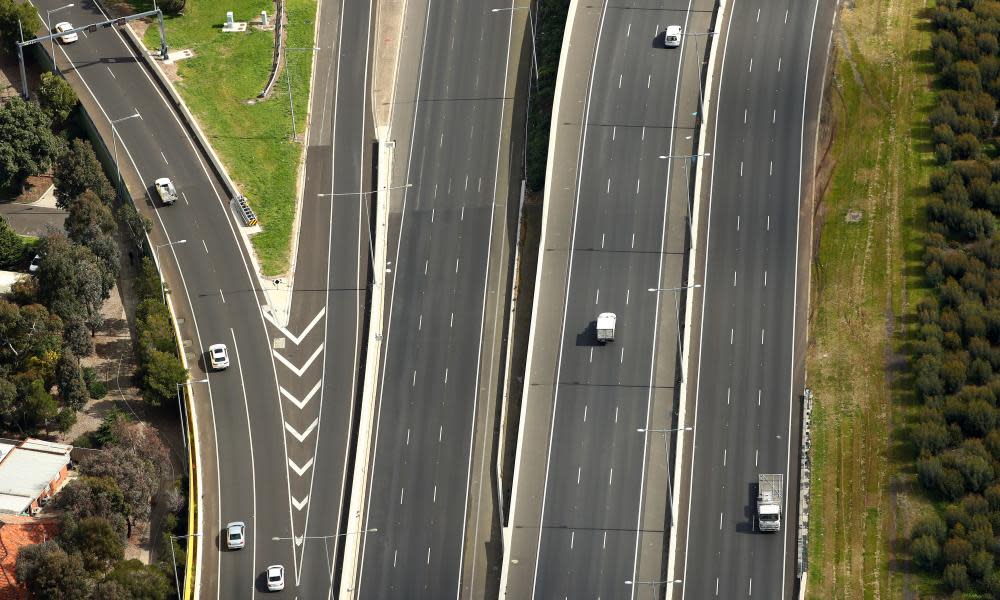Australia's emissions fell 3% in year to June amid Covid shutdown

Australia’s greenhouse gas emissions fell 3% in the year to June due to the Covid-19 shutdown, the ongoing impact of drought and an influx of cheap solar and wind power, according to government figures.
The government said it meant Australia had beaten its international 2020 target – widely regarded among experts as an unambitious goal.
Experts said much of the fall in emissions over the year were unrelated to federal government action.
The quarterly update on emissions released on Monday showed the pandemic had caused a sharp drop in transport emissions of 6.7% over the year to June as there were fewer cars on roads, and passenger flights dropped to almost nil in the early months of this year.
Related: Scott Morrison's climate language has shifted – but actions speak louder than words
The ongoing effects of drought caused a 3.7% drop in agricultural emissions, with farms carrying less livestock and using less fertiliser.
Electricity emissions were down 4.3%, largely due to the construction of wind and solar plants commissioned to meet the national 2020 renewable energy target. The target was filled last year and the federal government did not replace it, but the states are increasingly backing clean energy.
But emissions continued to increase from stationary energy, which includes the manufacturing, construction and commercial sectors. They were up 3.1%, mostly due to increases in the production of liquified natural gas for export. A large part of that comes from Queensland’s massive LNG export industry.
The energy and emissions reduction minister, Angus Taylor, said Australia’s emissions in the year to June of 513.4m tonnes were the lowest level since 1998.
He said the government had beaten its 2020 emissions target, a 5% cut below 2000 levels, by 459m tonnes of CO2. This is a cumulative figure, calculated compared with where Australia’s emissions were relative to targets across the years 2008 and 2020.
The government has said it could claim these 459m tonnes as “carryover credits” against its 2030 target under the Paris agreement. Australia is the only country proposing to do this and the plan has been heavily criticised by other countries.
Scott Morrison said in a speech to the Business Council of Australia this month that he now believes the government may not need to use these credits. The latest government emissions projections, released in December last year, suggested it would miss the 2030 target without them. New projections are due next month.
Prof Frank Jotzo, director of the Centre for Climate Economics and Policy at Australian National University, said: “These reductions in emissions are almost entirely due to the competitiveness of renewable energy sources and to circumstances that have nothing to do with federal government policy.”
Australia’s levels of emissions can be communicated in a variety of ways. Large emissions savings from a fall in land clearing in the past two decades also influence them.
The government’s data shows that if those land use changes are excluded emissions from other sectors of the economy have gone up slightly since 2005 – the baseline year against which national emissions targets for 2030 are measured.
Great news! Australia's emissions are 16.6% below 2005 levels!!! (*if we include land use)
If we exclude land use like everyone else does, our emissions are 1.2% *higher* than in 2005
Greta job, Angus, well done pic.twitter.com/eUpSvrovzz— Greg Jericho (@GrogsGamut) November 29, 2020
Jotzo said Australia’s Paris agreement target to cut emissions to 26% to 28% below 2005 levels by 2030 could be raised with just modest policies at a federal level.
“It’s becoming more and more evident that the existing 2030 target can be readily made without the use of the carryover credits,” he said. “A stronger 2030 target could be readily made with some sensible policy efforts.
“The drivers for that are increasing renewable energy, meaning less and less coal-fired power on the grid. These are tremendous savings.”
The Morrison government has resisted calls to commit to a target of net-zero emissions by 2050 despite it having now been adopted by Australia’s main trading partners. The world’s leading emitter, China, has pledged to reach net-zero before 2060 and the US under president-elect Joe Biden will also adopt a 2050 net-zero target.
International policy experts have said such a target is achievable for Australia, but only if federal government policies were developed in industry and transport sectors.
Taylor said: “The government is taking real and meaningful action to reduce emissions, including through the $1.9 billion new energy technologies investment package to support investment in new and emerging low-emissions technologies.”
Analysis from the University of Technology Sydney has warned that the government’s failure to renew the renewable energy target could lead to 11,000 jobs being lost from the renewable energy industry.
The greenhouse data was released as a survey of business leaders found a majority believed the government was not doing enough to combat the climate crisis as part of the economic recovery plans from Covid-19.
The survey by the Carbon Market Institute found three-quarters of respondents had said the government should be doing more to deal with emissions as part of its response to the pandemic and 88% supported setting a net zero emissions target for 2050.
John Connor, the institute’s chief executive, said business leaders were increasingly taking action but wanted the government to set the way with targets and policies, not just support technology development.
Nikola Casule, Greenpeace Australia Pacific’s head of research, characterised the falling emissions as “Angus Taylor’s Stephen Bradbury moment” – referring to the 2002 Australian speed skating Olympic gold medallist who won after his competitors fell at the final turn.
“It took a global pandemic, dodgy accounting and relying on other parties’ policies to achieve this,” Casule said.
“But as more states and businesses switch to renewables and set net-zero emissions targets by 2050, the Morrison Government is increasingly isolated, not only from other Coalition governments but globally as well.”

 Yahoo Movies
Yahoo Movies 
